Insulators and Asbestos Exposure
Insulators are employed in many fields and are responsible for installing and replacing insulation material to control and maintain the temperature. Exposure to asbestos insulation is a significant health hazard for insulation workers in older residential and industrial settings.

Written by Sean Marchese, MS, RN • Edited By Walter Pacheco • Scientifically Reviewed By Dr. Jerald L. Cook
Asbestos.com is the nation’s most trusted mesothelioma resource
The Mesothelioma Center at Asbestos.com has provided patients and their loved ones the most updated and reliable information on mesothelioma and asbestos exposure since 2006.
Our team of Patient Advocates includes a medical doctor, a registered nurse, health services administrators, veterans, VA-accredited Claims Agents, an oncology patient navigator and hospice care expert. Their combined expertise means we help any mesothelioma patient or loved one through every step of their cancer journey.
More than 30 contributors, including mesothelioma doctors, survivors, health care professionals and other experts, have peer-reviewed our website and written unique research-driven articles to ensure you get the highest-quality medical and health information.
About The Mesothelioma Center at Asbestos.com
- Assisting mesothelioma patients and their loved ones since 2006.
- Helps more than 50% of mesothelioma patients diagnosed annually in the U.S.
- A+ rating from the Better Business Bureau.
- 5-star reviewed mesothelioma and support organization.
Testimonials
My family has only the highest compliment for the assistance and support that we received from The Mesothelioma Center. This is a staff of compassionate and knowledgeable individuals who respect what your family is experiencing and who go the extra mile to make an unfortunate diagnosis less stressful. Information and assistance were provided by The Mesothelioma Center at no cost to our family.LashawnMesothelioma patient’s daughter
How to Cite Asbestos.com’s Article
APA
Marchese, S. (2023, June 20). Insulators and Asbestos Exposure. Asbestos.com. Retrieved April 19, 2024, from https://www.asbestos.com/occupations/insulators/
MLA
Marchese, Sean. "Insulators and Asbestos Exposure." Asbestos.com, 20 Jun 2023, https://www.asbestos.com/occupations/insulators/.
Chicago
Marchese, Sean. "Insulators and Asbestos Exposure." Asbestos.com. Last modified June 20, 2023. https://www.asbestos.com/occupations/insulators/.
How Are Insulation Workers Exposed to Asbestos?
Insulation workers typically determine the amounts and types of insulation required during construction. They also decide the installation methods based on location, surface shape and equipment use. Insulation reduces heating and cooling costs by more than 40% and builders use it for sound reduction and energy efficiency.
Although insulation has many benefits today, it posed serious health risks for insulators who worked between the 1930s and the 1970s. Toxic asbestos, known for its ability to retain temperature, was used in just about all insulation manufactured during that time.
In 2016, a Swedish study published in Epidemiology and Health reported the incidence of asbestos-related cancer in workers between 1961 and 2009. The rate of pleural mesothelioma for insulators was more than ten times higher than the general population rate.
Asbestos and vermiculite insulation was the most significant source of asbestos exposure for insulators throughout the 1900s. It was used in homes, buildings, ships, cars and manufacturing facilities, to name a few. If the construction needed insulation, builders used asbestos.
Current insulators may still be at risk of exposure if they work with or around buildings, structures or machinery that contain asbestos insulation manufactured before the 1980s.
Asbestos Products Associated with Insulation Workers
When insulators inserted asbestos-containing wall insulation directly behind drywall between the studs, it had the potential to rip and tear, releasing asbestos fibers into the air.
Because of its composition, asbestos becomes dangerous when pieces break away and float in the air. Even a tiny amount contains tens of thousands of microscopic fibers.
When covering a steam pipe, insulation workers measure and cut insulation sections to the proper length and stretch them open. Asbestos pipe insulation is usually old and brittle, making it likely to disperse asbestos fibers.
Once insulators inhale asbestos fibers, some can become lodged in organ tissues and remain there throughout life. The accumulation of fibers can cause inflammation and scarring that may lead to the development of mesothelioma cancer and other asbestos-related illnesses.
Zonolite Insulation: Zonolite insulation is one of the most recognized asbestos insulation brands for HVAC systems. Insulators used loose-fill Zonolite in attics and walls. Asbestos-contaminated vermiculite from the infamous mine in Libby, Montana, was used for decades to insulate millions of American homes.
Pipe Insulation: Pipe covering and insulation controls the temperature of hot pipes, especially in shipbuilding, and remains one of the most common ways workers are exposed to asbestos today. With degradation caused by heat and time, pipe insulation becomes highly friable.
Block Insulation: Insulators use block insulation on the concrete blocks of homes, apartments and other buildings to maintain hot and cold temperatures. Environmental or construction damage to buildings with asbestos block insulation releases fibers into the air.
Spray-Applied Insulation: Spray-applied insulation is a simple, inexpensive way to provide thermal insulation in attics, walls, ceilings and other spaces. Asbestos was a common additive in spray-applied insulation before regulations limited its use in 1990.
Valve Insulation Jackets: Insulators used this asbestos insulation product for boilers, flanges, pipework, expansion joints and other temperature-sensitive equipment. As the jackets wear down through everyday wear and tear, asbestos fibers can become airborne.
Manufacturers Who Made Products Insulators Use
Insulators are put at risk by the manufacturers using asbestos in products. Asbestos litigation has named many of these companies for endangering the health and lives of insulators, construction workers and industrial workers.
A. P. Green Industries: A.P. Green Industries used asbestos to manufacture refractory products from the 1940s to the 1970s.
A C & S Inc.: A C & S installed asbestos insulation in commercial and industrial buildings from 1958 to 1985.
Armstrong World Industries/ Fibreboard Paper Products Corporation: Armstrong World Industries manufactured asbestos products until the 1970s.
C. E. Thurston & Sons: C.E. Thurston & Sons sold, installed, repaired and removed asbestos insulation products until the late 1970s.
Celotex: Celotex manufactured asbestos insulation and construction materials from the 1920s to the 1980s. The company also operated an asbestos mine until 1986.
CertainTeed Corporation: The CertainTeed Corporation incorporated asbestos in its manufactured construction materials from 1930 to 1993.
Combustion Engineering: Combustion Engineering used asbestos to manufacture boilers, cement, insulation, adhesives and coatings, which resulted in thousands of asbestos lawsuits.
Crown Cork and Seal: Crown purchased Mundet Cork in 1963, which produced insulation products and cement containing large amounts of toxic asbestos.
EaglePicher: EaglePicher produced asbestos insulation products for the military until the mid-1970s. In 1996, EaglePicher created a $400 million trust fund for asbestos compensation.
GAF Corporation: Until the 1980s, GAF Corporation manufactured asbestos-containing construction materials. GAF’s purchase of Ruberoid included several asbestos products.
Johns Manville: Founded in 1858, Johns Manville is one of the first companies to manufacture products with asbestos, including roofing, insulation and automotive sheet cylinder packing.
Kaiser Aluminum: Kaiser Aluminum made and sold asbestos-containing products, including firebrick, insulation and refractory cement, from the 1950s through the 1970s.
Ehret Magnesia: Ehret Magnesia manufactured asbestos-containing insulation products until 1972. The company created a trust fund with $45 million to handle asbestos claims.
National Gypsum Company: National Gypsum was known for its Gold Bond brand, under which it made insulation and other asbestos-containing construction materials.
Garlock: Founded in 1907, Garlock used asbestos to manufacture gaskets, valve packing and packaging materials until 1980.
Nicolet (Keasbey & Mattison): The Nicolet Company, formerly known as Keasbey & Mattison, developed pipe insulation with asbestos throughout the 20th century.
Owens Corning/Fibreboard: Owens Corning manufactured asbestos insulation products from the 1950s through 1972. The company filed for bankruptcy in 2000 after asbestos litigation.
Owens-Illinois: Under the brand name Kaylo, Owens-Illinois Inc. manufactured asbestos insulation in the 1940s and 1950s.
Pacor Incorporated: Founded in 1921, Pacor Incorporated made and distributed asbestos insulation products, including contaminated products manufactured by Johns Manville.
Rock Wool Manufacturing: Rock Wool Manufacturing Company was a wool insulation manufacturer that used asbestos in several of its products until the 1970s.
Shook & Fletcher: Shook and Fletcher Insulation Company manufactured asbestos insulation products from 1949 through the 1970s. The company filed for bankruptcy in 2002.
The Flintkote Company: The Flintkote Company used asbestos in insulation and roofing materials from the 1930s until the 1980s. The company filed for bankruptcy in 2014.
Unarco: The Union Asbestos and Rubber Company manufactured various asbestos insulation products throughout the 20th until the company went bankrupt in 1982.
Western MacArthur: Western MacArthur made and distributed asbestos pipe covering and other insulation products from 1913 until the late 1970s.
W.R. Grace & Company: W.R. Grace & Co. made insulation products with asbestos and, until 1990, owned an asbestos-contaminated vermiculite mine in Libby, Montana.
Insulators and Mesothelioma
According to a 2022 report by the European Commission, over 70,000 workers died in 2019 from past exposure to asbestos.
A 2017 study in the American Journal of Industrial Medicine reviewed the cases of 1,517 asbestos insulators. The researchers found that 77% of patients had pleural mesothelioma, 22.7% were peritoneal and 0.3% were pericardial. Asbestos insulators who become ill have the best chance of improving their prognosis by seeking a mesothelioma specialist.
In 2018, a report in the European Respiratory Journal found that 54% of insulators continue to face exposure to asbestos products in their work environments. The occupational effects of asbestos exposure in insulators also cause more lung abnormalities such as COPD.
A 1991 report in the Annals of the New York Academy of Sciences published results showing that more than 80% of long-term asbestos insulation workers developed asbestosis. Approximately 40% of the workers’ deaths were attributable to asbestos exposure.
According to another 1991 study published in Environmental Health Perspectives, insulators at a U.S. Navy shipyard experienced a higher lung cancer mortality rate. Insulators who worked at this facility before 1979 had an increased risk of developing lung cancer, asbestosis, mesothelioma and other asbestos-related diseases.

Legal Options for Insulation Workers Exposed to Asbestos
Insulators have been successful in getting compensation and have also been awarded successful verdicts in lawsuits against manufacturers using asbestos in products that caused asbestos-related diseases. Workers may be eligible to file personal injury lawsuits, while those who have lost a loved one to mesothelioma may qualify to file a wrongful death lawsuit. Both workers and family members who have lost a loved one may be eligible to file a claim with a trust fund.
Rhonda Evans was the wife of a 25-year employee of the Los Angeles Department of Water and Power. Over that time, Rhonda developed mesothelioma from secondhand asbestos exposure after washing her husband’s work clothes. He had worked with CertainTeed asbestos-contaminated products. In April 2010, a Los Angeles jury awarded her $208.8 million.
In 2001, A C & S, Inc. faced a trial for asbestos litigation involving five workers exposed to the company’s products, including insulating cement, pipefitting, asbestos bricks, cement blocks and pipe covering. A C & S joined Harbison-Walker Refractories and A.P. Green Industries in paying out $40 million in compensation for the claimants.
Between 1952 and 1986, Kenneth Wayne Jackson worked as a pipefitter at a Combustion Engineering plant in Chattanooga, Tennessee. After Jackson developed mesothelioma and passed away, his widow filed a wrongful death lawsuit with a mesothelioma lawyer against the asbestos manufacturers. In 2009, a Tennessee jury awarded the Jackson estate $1.4 million.
Finding a lawyer with expertise in handling asbestos claims can ensure your legal team has the experience and resources to secure the most compensation for your case.









